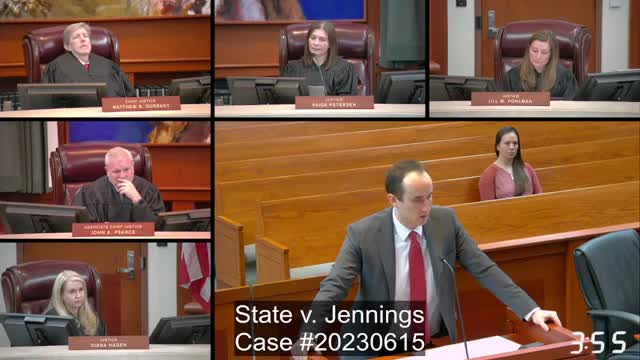Legal debate on self defense standards and mental state in stabbing case
October 28, 2024 | Utah Supreme Court, Utah Judicial Branch, Utah
This article was created by AI summarizing key points discussed. AI makes mistakes, so for full details and context, please refer to the video of the full meeting. Please report any errors so we can fix them. Report an error »

In a recent oral argument before the Utah Supreme Court regarding the case of State v. Jennings, significant discussions emerged surrounding the complexities of self-defense laws and the mental state required for justifying the use of force. The case centers on whether Jennings acted within his rights when he used a sharp object during a confrontation, leading to serious injuries.
The court examined the legal definitions of "force" and "self-defense," particularly focusing on the mental state of the individual using force. One key point raised was the distinction between the subjective belief of the defendant about the necessity of force and the objective nature of the force used. The justices questioned whether Jennings could reasonably believe that the force he employed was necessary if he was unaware of the weapon in his hand. This raises critical implications for how self-defense is interpreted in legal contexts, especially concerning the mental state of the accused.
The discussion also touched on the statutory language that requires an individual to use force that is "intended or likely to cause death or serious bodily injury." The justices debated whether the focus should be on the defendant's knowledge of the weapon or the objective assessment of the injuries inflicted. This distinction is crucial, as it could determine the outcome of Jennings' defense.
Additionally, the argument referenced previous cases where accidental discharges of firearms were considered within the realm of self-defense. This aspect of the discussion highlighted the varying interpretations of self-defense across jurisdictions, suggesting that the legal landscape is not uniform and can lead to different outcomes based on specific circumstances.
The implications of this case extend beyond Jennings himself, as the court's ruling could set a precedent for how self-defense claims are evaluated in Utah. The outcome may influence future cases involving the use of force and the necessary mental state for justifying such actions.
As the court deliberates, the community watches closely, aware that the decision could have lasting effects on self-defense laws and the rights of individuals in similar situations. The case underscores the ongoing complexities of legal interpretations surrounding self-defense and the balance between individual rights and public safety.
The court examined the legal definitions of "force" and "self-defense," particularly focusing on the mental state of the individual using force. One key point raised was the distinction between the subjective belief of the defendant about the necessity of force and the objective nature of the force used. The justices questioned whether Jennings could reasonably believe that the force he employed was necessary if he was unaware of the weapon in his hand. This raises critical implications for how self-defense is interpreted in legal contexts, especially concerning the mental state of the accused.
The discussion also touched on the statutory language that requires an individual to use force that is "intended or likely to cause death or serious bodily injury." The justices debated whether the focus should be on the defendant's knowledge of the weapon or the objective assessment of the injuries inflicted. This distinction is crucial, as it could determine the outcome of Jennings' defense.
Additionally, the argument referenced previous cases where accidental discharges of firearms were considered within the realm of self-defense. This aspect of the discussion highlighted the varying interpretations of self-defense across jurisdictions, suggesting that the legal landscape is not uniform and can lead to different outcomes based on specific circumstances.
The implications of this case extend beyond Jennings himself, as the court's ruling could set a precedent for how self-defense claims are evaluated in Utah. The outcome may influence future cases involving the use of force and the necessary mental state for justifying such actions.
As the court deliberates, the community watches closely, aware that the decision could have lasting effects on self-defense laws and the rights of individuals in similar situations. The case underscores the ongoing complexities of legal interpretations surrounding self-defense and the balance between individual rights and public safety.
View full meeting
This article is based on a recent meeting—watch the full video and explore the complete transcript for deeper insights into the discussion.
View full meeting

